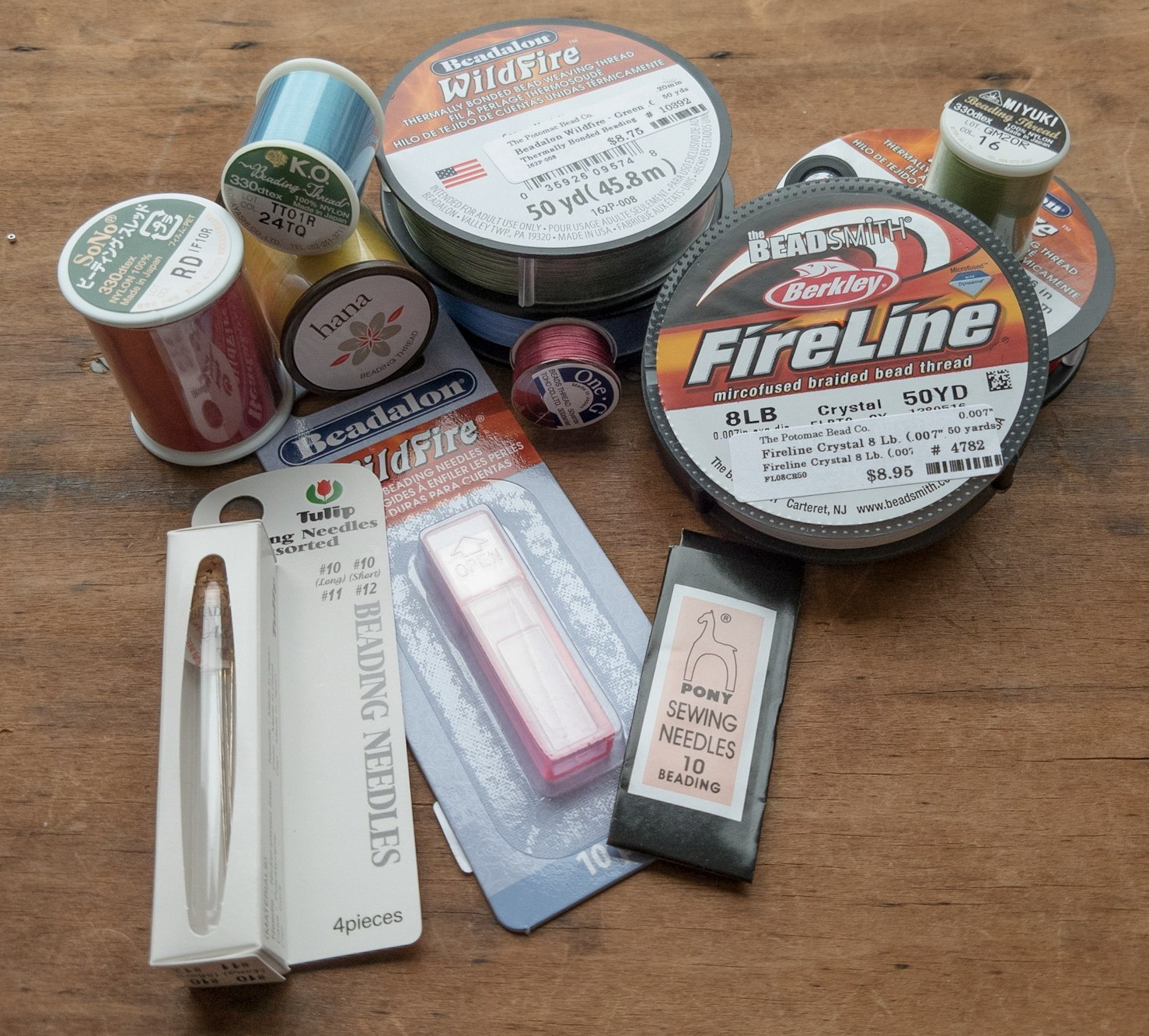- Jewelry-Making Supplies ▾
Design Jewelry with Confidence!
Seed Beads
Thread, Wire, & Stringing Materials
Athenacast Findings & Components
Everything Else
- Kits & Collections ▾
Assemble Your World
Kits & Collections
- Subscriptions ▾
Want monthly Beading Happiness?
Subscriptions
- Learn to Make ▾
Want to learn more?
- Discounts & Deals ▾
Explore Today's Promotions!
- Jewelry-Making Supplies
- Kits & Collections
- Subscriptions
- Learn to Make
- Discounts & Deals
-
Seed Beads
Thread, Wire, & Stringing Materials
Findings & Components
Everything Else
-
Kits & Collections
-
Subscriptions
Thread & Needles: One Beader's Review (Part 1: Thread Types)
PAGE VARIABLES - ONLY VISIBLE ON EDIT MODE *
Subtitle
When I first learned the technique of beadweaving, I learned from a friend who had her own needle and thread preferences. The overwhelming selection of threads and needles available, and an incomplete knowledge of every brand, prevented me from venturing too far from my beginnings. After a couple years of almost exclusively using the brands I had learned with, I realized that I needed to expand my horizons and try different brands for myself.
Blog Date
Blog Author
Blog Author Preview - NOTE: To change author, edit page attribute page selection
Blog Tags
Blog Category
bodyHtml
- Home
- PotomacBeads DIY Blog
- Thread & Needles: One Beader's Review (Part 1: Thread Types)

When I first learned the technique of beadweaving, I learned from a friend who had her own needle and thread preferences. The overwhelming selection of threads and needles available, and an incomplete knowledge of every brand, prevented me from venturing too far from my beginnings. After a couple years of almost exclusively using the brands I had learned with, I realized that I needed to expand my horizons and try different brands for myself.
I chose to gather some of the most popular and accessible types of both needles and threads. After threading each needle with one of the threads, I used each pairing to stitch a short strip of peyote, one of the most common stitches. Although all of the products I tested will produce a great project, knowing the subtle differences between them will help you choose the needle and thread that you most enjoy working for your project. Keep in mind that while there are certain properties that are quantifiable, what I am mostly concerned with here is the overall experience of using these tools.
Threads I Tested:
- Wildfire
- Fireline
- Miyuki KO
- SONO
- Hana
Needles I Tested:
- Pony, Size 10
- Beadalon Wildfire, Size 13
- Tulip, Size 10, 11, and 12
Thread
Generally, the threads fell into two categories: those that were thermally bonded and braided and those that were not. Although all of the threads are nylon, the thermal bonding gives these threads some unique characteristics.
Thermally Bonded Threads
Wildfire and Fireline are both thermally bonded and braided thread. There is a noticeably rougher texture with these threads. Thermal bonding means that it won’t fray at the cut end and will be more resistant to sharp bead edges. However, any thread will succumb to sharp bead edges or an accidental knick with your scissors. (I personally like to use a pair of Slip-N-Snips since they easily fold into themselves to hide the blades.) Thermally bonded threads also generally feel thicker and more substantial as you work with them.

Both Wildfire and Fireline are available in basic colors including black and white. Wildfire has a few more color options with green, blue, and red available. I’ve found green to be the most versatile. In Fireline, the Crystal seems to be the most versatile since it is not an opaque white, but rather a semi-transparent. The recent addition of the Black Satin color, which touts a smoother surface and permanent color, has made some loyal Fireline users very happy.
The thermally bonded nature of these threads also creates a thread that lacks in stretch. This is neither a good or bad quality, it will depend on your project. It is, however, something to consider when you select a thread. This characteristic, along with its texture, make it my preference for beadweaving projects.
Nylon Threads
All the other threads I compared fall into this category of Nylon threads. As I mentioned before, all these threads I looked into are Nylon, however these threads are not thermally bonded. A plain nylon thread is smoother and feels lighter. These threads more closely resemble sewing thread than the thermally bonded. These threads have a generally lighter, more delicate feel when you are working with them. If you are a loyal Wildfire or Fireline user, you will be surprised at the delicacy of these non-thermally bonded threads.




These nylon threads have an elasticity that makes them great for projects that require a little elasticity. These threads are not to be confused with elastic or stretch cord, but the extra bounce in these threads is great for some projects. I recently spoke with a fellow beader who thought the stretch was ideal for tassels. As I used the threads, I felt that SoNo was the least elastic and KO, One-G, and Hanna were all very similar and noticeably more bouncy.
Nylon threads also come in a wider variety of colors than Wildfire or Fireline. I was able to find a much wider variety of colors in KO and One -G with almost any color available that you might need. Although available in fewer colors, the Hana thread has a beautiful selection of vibrant colors, as shown below:




Now, when I have bead embroidery projects on a beading foundation, I use one of these nylon threads for my project rather than a thermally bonded thread. The
After working with these threads, I grew to appreciate the wide variety of threads available rather than being overwhelmed by numerous options. I've overheard many heated debates over which thread is the best and have realized that is all subjective. There is no BEST thread, there is only the best thread for you and your project. The only way to know which is the right one for you is to try them.
Next week, in Part 2, I will be sharing my thoughts on the needles I tested. Until then, have fun exploring new threads!
-Anna Taylor
Highest Quality
Products
100% Money
Back Guarantee
Fast
Shipping
Best Teaching &
Customer Service
You'll want these emails...
Get Free Projects & Inspiration
Get Free Projects & Inspiration
- Bullet 1
- Bullet 2
- Bullet 3
Copyright © PotomacBeads





